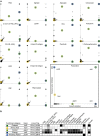Reconstruction of the metabolic network of Pseudomonas aeruginosa to interrogate virulence factor synthesis
- PMID: 28266498
- PMCID: PMC5344303
- DOI: 10.1038/ncomms14631
Reconstruction of the metabolic network of Pseudomonas aeruginosa to interrogate virulence factor synthesis
Abstract
Virulence-linked pathways in opportunistic pathogens are putative therapeutic targets that may be associated with less potential for resistance than targets in growth-essential pathways. However, efficacy of virulence-linked targets may be affected by the contribution of virulence-related genes to metabolism. We evaluate the complex interrelationships between growth and virulence-linked pathways using a genome-scale metabolic network reconstruction of Pseudomonas aeruginosa strain PA14 and an updated, expanded reconstruction of P. aeruginosa strain PAO1. The PA14 reconstruction accounts for the activity of 112 virulence-linked genes and virulence factor synthesis pathways that produce 17 unique compounds. We integrate eight published genome-scale mutant screens to validate gene essentiality predictions in rich media, contextualize intra-screen discrepancies and evaluate virulence-linked gene distribution across essentiality datasets. Computational screening further elucidates interconnectivity between inhibition of virulence factor synthesis and growth. Successful validation of selected gene perturbations using PA14 transposon mutants demonstrates the utility of model-driven screening of therapeutic targets.
Conflict of interest statement
The authors declare no competing financial interests.
Figures





Similar articles
-
Reconciling high-throughput gene essentiality data with metabolic network reconstructions.PLoS Comput Biol. 2019 Apr 11;15(4):e1006507. doi: 10.1371/journal.pcbi.1006507. eCollection 2019 Apr. PLoS Comput Biol. 2019. PMID: 30973869 Free PMC article.
-
Genome-wide identification of Pseudomonas aeruginosa virulence-related genes using a Caenorhabditis elegans infection model.PLoS Pathog. 2012;8(7):e1002813. doi: 10.1371/journal.ppat.1002813. Epub 2012 Jul 26. PLoS Pathog. 2012. PMID: 22911607 Free PMC article.
-
Impact of glycerol-3-phosphate dehydrogenase on virulence factor production by Pseudomonas aeruginosa.Can J Microbiol. 2014 Dec;60(12):857-63. doi: 10.1139/cjm-2014-0485. Can J Microbiol. 2014. PMID: 25409940
-
Which microbial factors really are important in Pseudomonas aeruginosa infections?Future Microbiol. 2015;10(11):1825-36. doi: 10.2217/fmb.15.100. Epub 2015 Oct 30. Future Microbiol. 2015. PMID: 26515254 Review.
-
A dynamic and intricate regulatory network determines Pseudomonas aeruginosa virulence.Nucleic Acids Res. 2013 Jan 7;41(1):1-20. doi: 10.1093/nar/gks1039. Epub 2012 Nov 11. Nucleic Acids Res. 2013. PMID: 23143271 Free PMC article. Review.
Cited by
-
Understanding Antimicrobial Resistance Using Genome-Scale Metabolic Modeling.Antibiotics (Basel). 2023 May 11;12(5):896. doi: 10.3390/antibiotics12050896. Antibiotics (Basel). 2023. PMID: 37237798 Free PMC article. Review.
-
Control of primary metabolism by a virulence regulatory network promotes robustness in a plant pathogen.Nat Commun. 2018 Jan 29;9(1):418. doi: 10.1038/s41467-017-02660-4. Nat Commun. 2018. PMID: 29379078 Free PMC article.
-
Bacterial metabolism and pathogenesis intimate intertwining: time for metabolic modelling to come into action.Microb Biotechnol. 2022 Jan;15(1):95-102. doi: 10.1111/1751-7915.13942. Epub 2021 Oct 21. Microb Biotechnol. 2022. PMID: 34672429 Free PMC article.
-
The transcriptional regulators of virulence for Pseudomonas aeruginosa: Therapeutic opportunity and preventive potential of its clinical infections.Genes Dis. 2022 Oct 1;10(5):2049-2063. doi: 10.1016/j.gendis.2022.09.009. eCollection 2023 Sep. Genes Dis. 2022. PMID: 37492705 Free PMC article. Review.
-
Metabolic and genetic basis for auxotrophies in Gram-negative species.Proc Natl Acad Sci U S A. 2020 Mar 17;117(11):6264-6273. doi: 10.1073/pnas.1910499117. Epub 2020 Mar 4. Proc Natl Acad Sci U S A. 2020. PMID: 32132208 Free PMC article.
References
-
- Allen R. C., Popat R., Diggle S. P. & Brown S. P. Targeting virulence: can we make evolution-proof drugs? Nat. Rev. Microbiol. 12, 300–308 (2014). - PubMed
-
- Centers for Disease Control and Prevention (US). et al.. Antibiotic resistance threats in the United States. https://stacks.cdc.gov/view/cdc/20705 (2013).
-
- Clatworthy A. E., Pierson E. & Hung D. T. Targeting virulence: a new paradigm for antimicrobial therapy. Nat. Chem. Biol. 3, 541–548 (2007). - PubMed
-
- Rasko D. A. & Sperandio V. Anti-virulence strategies to combat bacteria-mediated disease. Nat. Rev. Drug Discov. 9, 117–128 (2010). - PubMed
Publication types
MeSH terms
Substances
Grants and funding
LinkOut - more resources
Full Text Sources
Other Literature Sources

